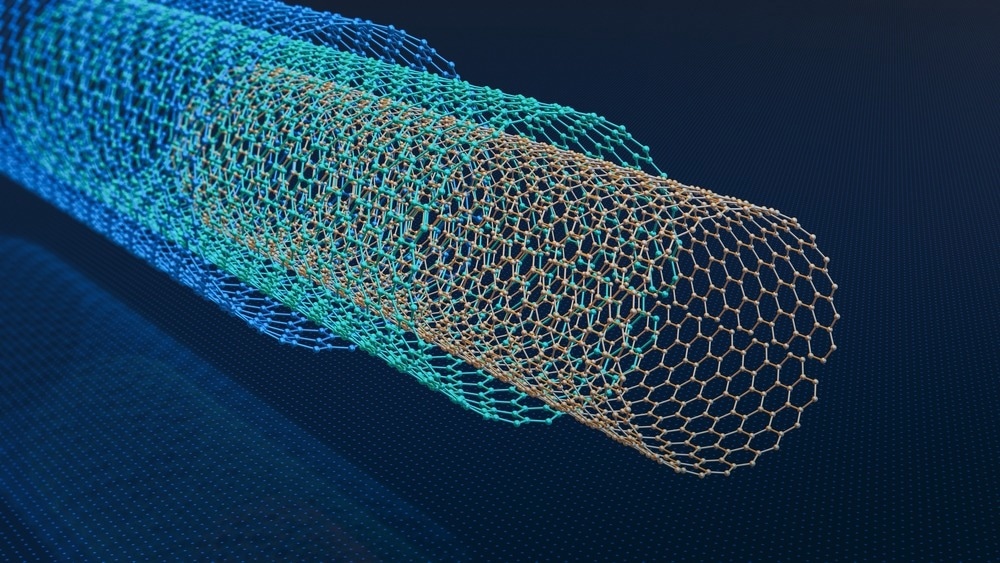Although Raman spectroscopy is a powerful and non-destructive chemical analysis, its application to characterize multi-walled carbon nanotubes (MWCNTs) is challenging due to their inhomogeneity, structural complexity, and complicated interlayer van der Waals (vdW) interactions.

Study: Role of Mechanical van der Waals Coupling in the G-Band Splitting of Individual Multiwall Carbon Nanotubes. Image Credit: lucadp/Shutterstock.com
Nevertheless, the inhomogeneity and vdW interactions in individual multi-walled carbon nanotubes can be investigated through combined analytical techniques, including atomic force microscopy (AFM), polarized Raman imaging, and spectroscopy by preparing on-chip purification of arc-discharge (AD) multi-walled carbon nanotubes powder.
An article published in The Journal of Physical Chemistry C discussed the inhomogeneity in individual AD multi-walled carbon nanotubes determined by Raman signal by extracting the inner layers of multi-walled carbon nanotubes during the sonication stage of the dispersion procedure.
A split in Raman-active G-band was observed and described in terms of the varying interlayer vdW coupling as a function of interlayer distance and diameter in tested AD multi-walled carbon nanotubes.
Furthermore, Raman mapping and advanced data fitting were used to investigate the polarization behavior of multi-walled carbon nanotubes that resulted in a non-uniform Raman response. Thus, the present work gave insights into inhomogeneous multi-walled carbon nanotubes and differentiated between the one-dimensional (1D) moiré crystals and multi-walled carbon nanotubes based on disintegrated single walled carbon nanotubes (SWCNTs) or by investigating 1D vdW heterostructures via Raman spectroscopy.
Investigating Multi-walled Carbon Nanotubes using Raman Spectroscopy
Multi-walled carbon nanotubes are a special form of carbon nanotubes in which multiple single-walled carbon nanotubes are nested inside one another. They are mechanically strong owing to the sp2 type of carbon-carbon bond. They are characterized by a large surface area on the outer side and a broad hollow on the inner side and are often applied for encapsulation and molecular grafting.
The optical and electronic properties of multi-walled carbon nanotubes are determined by the metallic and semiconducting nature of the individual walls depending on the variable band gap endowed by the diameter and roll-up (chiral) angle. Besides, the electronic band structure of multi-walled carbon nanotubes has flat bands or pseudogaps due to tunable vdW electronic coupling and moiré interference.
Raman spectroscopy is an analytical technique where scattered light is used to measure the vibrational energy modes of a sample. The Raman effect originates from the inelastic scattering of light and can directly probe vibration/rotational vibration states in samples.
Raman spectroscopy yields information about the purity, defects, and tube alignment and assists in the distinction of the presence of multi-walled carbon nanotubes relative to other carbon allotropes. Raman spectroscopy has been strikingly successful at describing the structural properties of SWCNTs. Unfortunately, interpreting the spectra for multi-walled carbon nanotubes is often very complicated and has not yet yielded a similar range output as Raman spectroscopy has achieved for SWCNTs.
Characterization of Multi-walled Carbon Nanotubes
Characterizing multi-walled carbon nanotubes is a prerequisite for many fundamental studies. Resonant Raman spectroscopy (RRS) could serve as a robust technique in this framework, which previously provided substantial information for SWCNTs. However, the inhomogeneity, structural complexity, and complicated interlayer vdW interactions in multi-walled carbon nanotubes restrain the application of the RRS technique and do not yield similar output.
In the present work, the role of structural inhomogeneity and mechanical vdW coupling was investigated to characterize individual multi-walled carbon nanotubes via combined AFM, RRS measurements, and polarized Raman imaging.
The pure individual multi-walled carbon nanotubes were obtained from their AD-synthesized versions via the on-chip purification method. The findings revealed that the nonuniformity of the Raman signal from AD- multi-walled carbon nanotubes was due to the extraction or damage of the inner layers through the dispersion procedure’s sonication step.
The isolated individual multi-walled carbon nanotubes were reported with the splitting of the Raman active G-band, which was described in terms of varying interlayer mechanical vdW coupling and as a function of interlayer distance and diameter. Thus, the present work has added insights into structurally inhomogeneous multi-walled carbon nanotubes, allowing the differentiation between multi-walled carbon nanotubes and 1D moiré crystals.
Conclusion
To conclude, the inhomogeneity of the Raman signal obtained from AD multi-walled carbon nanotubes was attributed to the extraction or damage of inner layers during the dispersion procedure. Moreover, the Raman-active G-band splitting in individual multi-walled carbon nanotubes was interpreted with respect to the effect of interlayer mechanical vdW coupling.
Ultimately, the present work revealed a practical approach toward determining the polarization behavior of multi-walled carbon nanotubes via non-uniform Raman response through Raman mapping and advanced data fitting that also helped identify the antenna effect. Thus, the present work gave insights into the structure of multi-walled carbon nanotubes and differentiated between multi-walled carbon nanotubes and 1D moiré crystals.
Reference
Avramenko, M. V., Hokkanen, M. J., Slabodyan, Y., Ahlskog, M., Levshov, D.I. (2022). Role of Mechanical van der Waals Coupling in the G-Band Splitting of Individual Multiwall Carbon Nanotubes. The Journal of Physical Chemistry C. https://pubs.acs.org/doi/10.1021/acs.jpcc.2c03590
Disclaimer: The views expressed here are those of the author expressed in their private capacity and do not necessarily represent the views of AZoM.com Limited T/A AZoNetwork the owner and operator of this website. This disclaimer forms part of the Terms and conditions of use of this website.